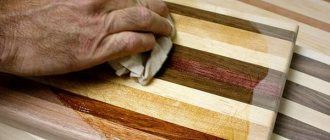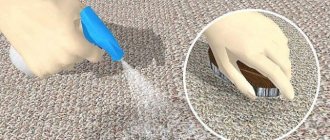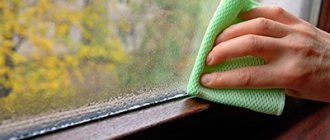Carpet is sold in rolls with raw edges. It is cut to the required size and laid with glue, tape or stretching technology. But if you lay carpet without fastening, like a rug, you will be faced with the question - how to process the edges of the carpet? The carpet must be treated or otherwise “overlocked”.
Overlocking carpet
Carpet overlocking – processing the edges of the carpet using special equipment or manually with your own hands. Thanks to this procedure, the carpet is given a finished, neat appearance, its edges do not unravel, and as a result, the service life of the material increases.
You can overlock carpet using both threads and ribbons. In modern stores there is a large selection of ribbons and threads of various colors on sale, so you can choose them to match any color of the carpet.
If you overlay the carpet, it will look more like a carpet or rug. In this case, you can round the edges of the canvas or cut out some geometric shapes. It’s unlikely to be possible to do this without an overlocker, since the edges will unravel, ride up over time, and the adhesive base will crumble.
Accordingly, processing the edges of the carpet is not required if its edges are hidden under the baseboard.
Advice! Do not rush to throw away the remnants of the carpet after laying it; they can be used to make beautiful, neat rugs after finishing the edges. They will look great in the bathroom, toilet, they can be placed under the feet of the beds.
Methods of protection against shedding
You can also process the edges of the carpet using faster accessible methods:
- The edges of synthetic coatings can be scorched with fire (lighter, matches, candle). Those who braided nylon bows into their braids probably remember this method of protection against shedding. The fire seals the fibers together, and they will not fray. You must act carefully so as not to damage the coating. Observe safety precautions: open fire is always associated with a risk of fire;
- use transparent PVA glue or a special gel that is used to glue decorative elements to the fabric. This method is suitable for natural and long-pile carpets. It is applied to the cut edge and allowed to dry. This is a short-lived protection, and the glue can be noticeable.
In order not to think about how to process a carpet without an overlocker, there is a very convenient option - to lay the covering from wall to wall, under the baseboard. The edges will hide, and the issue of processing will disappear by itself. And the plinth in this case will also act as an additional decorative element.
Overlocking carpets
For the overlocking procedure, special devices are used that can operate at low and high speeds.
Small, compact models are usually used for finishing edges at home.
But for industrial rubber-based carpet, more serious units are used - stationary equipment installed in a specific location.
Surface tear repair
Applying mastic
If the backing is not damaged, lift the torn section of the carpet, clean off the lint and spread a thin film of mastic onto the backing.
Sealing the tear
Holding the edges of the tear with your hand, smooth the surface of the carpet with a smooth object, such as a soda bottle. Pressing the carpet tightly, move the bottle in the direction from the tear in different directions to evenly distribute the mastic under the carpet between the fibers without squeezing it onto the surface. If glue does come out, remove it immediately with water and carpet cleaning shampoo. Four to five hours after the glue has dried, sew on the loose fibers.
Video: cutting and overlocking carpet
In other cases, you may need to overlock carpet at home. Such services are provided by specialized studios or individuals. To search, you can use newspapers and websites with advertisements. A specialist with a special device will come to you and sweep the edges of the carpet according to your preferences.
Typically, the color of threads or ribbons for overlocking is selected in accordance with the color of the coating. But you can make the carpet fabric original by choosing contrasting threads or tape.
Thread selection
Only threads made of 100% polypropylene are suitable for processing carpet.
Only threads made of 100% polypropylene are suitable for processing carpet. Due to the fact that the threads are made from artificial material, their high strength and wear resistance are ensured. They can be used with any type of overlocker.
Polypropylene threads have other advantages:
- In terms of strength, they are many times superior to natural-based products.
- Polypropylene threads are highly resistant to various acids and solvents.
- A large range of colors makes it easy to choose a finish to match the color of the coating.
- Such threads are not afraid of even sub-zero temperatures; they do not crumble or break.
The only drawback is that the threads quickly fade in direct sunlight. Typically, processing is carried out after the carpet has been given the desired shape and dimensions. Then the edges are processed with polypropylene threads. Sometimes nylon threads are added to them to increase the strength of the seam and enhance the brightness. The seam density should be high.
How to trim the edges of carpet with your own hands
Not everyone can afford to call a specialist to process the edges of the coating. Some people have little finances, some live far from the city or are used to doing everything on their own, etc.
What you need to overlock carpet at home
- synthetic threads or tape;
- very sharp, thick and reliable needle with a large eye;
- thimble to protect fingers;
- powerful scissors.
Advice! To calculate the approximate amount of thread for finishing the edges, multiply the total length of all sides of the fabric by 10. You will get an approximate figure, so take it with a margin.
Overlocking at home: step-by-step instructions
At first glance, the procedure is simple, especially for those who know how to hold a needle in their hands, but finishing the edges can take a very long time.
The procedure is performed using a regular loop stitch. First you need to evenly measure and cut the edges of the covering.
Now point by point:
- We make the first puncture at a distance of 5-15 mm from the edge. This indentation depends on the thickness of the coating - the thicker it is, the greater the indentation.
- We stretch the thread and throw it on the needle. Next, pull the thread to the left and tighten it well around the edge of the carpet.
- Insert the needle into the same hole again. We pull the thread again and throw it on the needle. Now pull the thread to the right and tighten it.
- We retreat a short distance from the first puncture and make a second one. The distance between the punctures depends on the density of your overlock - the smaller, the denser.
- We repeat the previous steps.
Industrial
If you plan to make money using an overlocker, then purchase industrial models. When choosing them, pay attention to reliability and ability to withstand heavy loads over a long period of time. Such equipment must be multifunctional.
First, to promote your business, you can purchase an inexpensive and reliable class 51 overlocker, and when you already have many orders and serious income, you can buy a modern, powerful, industrial four-thread overlocker, which will perform various types of seams and work with both knitted and and with drape, denim fabrics, carpet.
If you are working with thin carpet, then a presser foot lift of 15 mm is sufficient. When working with long-pile coverings, it should be 25 mm. It is better to purchase equipment with automatic lubrication, in which oil is poured into the tank, after which it is pumped through all components, this ensures high-quality operation over a long service life.
How to process the edge of a carpet with a ready-made overlocker
In stores you can find ready-made decorative overlock for carpet. It is usually attached to the edges with double-sided adhesive tape and glue.
This overlocker is glued to the base of the coating
Corner processing
Trimming at joints
All joints must be treated with glue
Gluing the finished overlocker
Another option for a ready-made decorative overlock
Sealing joints
Ready product
Equipment
You can overlock carpet using high- and low-speed special machines.
You can overlock carpet using high- and low-speed special machines (overlockers). Using such equipment, you can not only make a neat seam around the perimeter of the product, but also make a fringe.
There are compact models on sale for use at home or for providing related services on-site. The price of such equipment is more reasonable in comparison with production models. However, compact portable units cannot be used to process rubber-based industrial carpets. They are only suitable for household carpet made from artificial or natural materials.
How to make a subfloor for a loggia or balcony with your own hands?
Large units are usually used in various industries. Most overlockers are heavy and large devices that are not designed to be transported from place to place, so processing is usually carried out in a special workshop.
Rug of stones
The idea to create a rug out of stones with my own hands came to me recently while I was working in the garden. I wanted to do something unusual, useful and beautiful for the garden. I had a small handful of river stones lying around in a corner of the garden area and I decided to work with them a little and make my own rock rug. When I finished, the result simply surprised me, I thought, how did such a thought never occur to me before? This is truly wonderful - for those who love nature and everything that brings us closer to it. This homemade product is a piece of wildlife in your home. It can be used almost everywhere - in the kitchen, bathroom, hallway, in front of the fireplace or in some cozy corner in your home. To create a rug of stones with your own hands, you will need to have on hand strong epoxy glue, scissors, river stones of various sizes and colors, and construction mesh of the appropriate color.
To begin, take a piece of construction mesh. On it you will assemble your rug of stones. Decide what size and shape you want your rug to be and cut the mesh accordingly. Although you can first assemble the shape of a rug on a single piece of mesh, and then cut it out along the edges. Do as you feel comfortable.
I wanted to make a round rug, but I started assembling it on a rectangular piece of construction mesh.
To obtain a relatively smooth surface, work with stones of approximately the same size. If you are not interested in having a smooth surface, for example, if the future rug is planned to be used only as decoration, then you can use stones of various sizes. You will get a relief rug. Do you want to use solid colored stones, or contrast the colors by using multi-colored stones. If you want to depict a pattern, make the background of the rug one color and the pattern another. The result will be a very attractive mosaic.
Assemble your rug of stones on the grid and when you decide on its final appearance and consider that it is finished, proceed to gluing.
Start gluing the stones to the mesh. Apply a small amount of strong adhesive to the back of the stone and press into the surface. The glue will leak through the holes in the mesh, so it's best to cover the work surface with something. While gluing the stones, it may happen that your design moves a little from its previous location. So keep this in mind before you start. When you're done with the drawing, continue working on the background. Glue the stones one by one until you get the rug you want. Cut off the remaining edges of the construction mesh with scissors.
Finally, your own DIY stone rug is made.
I placed it near the stairs at the entrance to the garden. He looks very nice there.
You can make a similar rug from stones with your own hands for the bathroom; place it near the bathtub or shower.
Here's another fantastic shoe idea - a tray filled with pebbles.
You can use such a rug as tiles in the bathroom or kitchen. Isn't it beautifully done?
It is also beautiful to use in front of the front door.
Cutters
Hand-held devices that allow you to make straight cuts in carpet without much effort. They come in several varieties and are suitable for certain types of this flooring:
- Universal cutters for carpet and linoleum. They have a trapezoidal cutting element, made in such a way that when cutting, the pile does not fall under it.
- Universal cutters for textile coverings. Using them you can cut carpet, PVC and materials with a foam base.
- Flooring cutters with jute base. In addition, they can be used to cut PVC, but such a tool is not at all suitable for those that have a foam base.
We suggest you read: How to wash a cashmere coat at home
Most of them come with a set of replacement blades.
Electric scissors
Electric scissors (electric knife) are a universal tool with replaceable attachments. Its purpose is to cut various flexible materials:
- paper;
- cardboard;
- fabrics;
- carpets and rugs, etc.
Buying electric scissors will be the smartest decision. They will quickly and easily solve the problem of cutting a carpet, and after completing the repair they will help solve a wide variety of problems many times. The electric knife has an affordable price (up to 2000 rubles). It is safe, simple and easy to use, compact in size. The device is powered not from the mains, but from a replaceable battery.
Electric scissors
Loop stitch
Another option is to sew the rug with a buttonhole stitch. Since a standard home sewing machine cannot handle the rug, you will have to sew it by hand. Choose strong, thick threads or thin lace for processing, because the floor covering is something that is subject to quite intense wear. You can choose threads to match the coating, which will be almost invisible. Or, on the contrary, you can use a contrasting color or a color that will resonate with the details of your interior or the pattern of the flooring. It depends on your imagination and taste. You can combine several colors, use textured laces, or group stitches to form a specific pattern.
Placing a patch on a bulky pile carpet
Attaching the damaged area to the floor
If the carpet is in tension, place strips of carpet scraps around the damaged area, about 200mm from the edges of the damaged area, and secure them with 25mm furniture nails at 75mm intervals. This procedure reduces the tension of the carpet in the patching area. If the rug is secured with tape or is lying loose on the floor, there is no need to secure it.
Cutting out the damaged area
Make a cardboard stencil to the size of the damaged area and place it on the carpet. Using the blunt side of a linoleum knife blade, part the carpet pile along the edges of the stencil, then push the pile apart with your fingers. Stencil along the backing of the rug, being careful not to cut into the backing, then lift the cut section up at one corner and remove it. Cut a patch from a carpet trim, using the cut section to match the direction of the pile and the pattern and a stencil to make the knife easier to work with.
Installing fabric tape
The patch will be held in place using fabric and mastic tapes on the back of the rug. Cut four strips of fabric so that they are approximately 25mm longer than the sides of the opening. Apply a thin layer of latex mastic to the tape and place the tape under the edges of the hole so that the seam lines are in the center of the tape. Apply a thin layer of glue to the edges of the hole, being careful not to get any glue into the carpet pile.
Attaching a patch
Match the slope of the grain and the pattern of the patch and carpet. Press the patch into place, starting from one corner and working towards the diagonally opposite corner, being careful not to stain the front of the carpet with any adhesive. Push the edges of the hole and patch together and press them together with your palms. Using an awl, loosen any carpet fibers or loops caught in the seam, then use your fingers to smooth the carpet fibers and patches until they blend together and the seam is no longer visible. Load the seam with a stack of books for several hours. If the carpet is stretched on the grippers, after approximately five hours, remove the temporarily nailed strips of carpet scraps and restore tension to the carpet using the tension tool.











